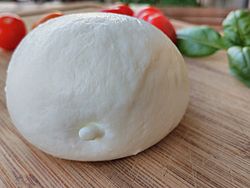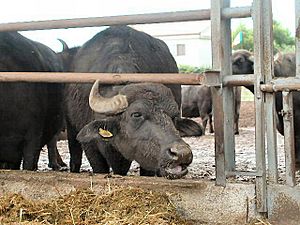Buffalo mozzarella facts for kids
Quick facts for kids buffalo mozzarella |
|
|---|---|
 |
|
| Other names | mozzarella di bufala |
| Country of origin | Italy |
| Region | Campania, Lazio, Puglia, and Molise |
| Source of milk | Italian water buffalo |
| Texture | Fresh |
| Certification | mozzarella di bufala campana: Italy: DOC 1993 EU: PDO 1996 |
| Named after | Lua error in Module:Wikidata at line 70: attempt to index field 'wikibase' (a nil value). |
Buffalo mozzarella (called mozzarella di bufala in Italian) is a special type of mozzarella cheese. It is made from the milk of Italian Mediterranean buffalo, not cows. This delicious dairy product has been made for a long time in Campania, a region in southern Italy.
The name "mozzarella" comes from the Italian word mozzare, which means "to cut by hand." This describes how the cheese is made: the cheesemaker cuts the soft cheese into small, individual pieces. People love buffalo mozzarella because it's stretchy and can be used in many different dishes. Some even call it "the queen of Mediterranean cooking" or "white gold"!
A special type of buffalo mozzarella, known as mozzarella di bufala campana, has a protected status. This means it can only be made in certain areas of Italy, like Campania, Lazio, Puglia, and Molise. It must also follow a traditional recipe to keep its special quality. This protection helps make sure you get the real deal!
Contents
Where Buffalo Mozzarella Is Made
In Italy, buffalo mozzarella is made all over the country using milk from Italian buffalo. However, the very special mozzarella di bufala campana with its protected status is mainly produced in an area stretching from Rome to Paestum in Campania. You can also find production areas in parts of Puglia and Molise.
This cheese is a big business in Italy, bringing in about €300 million (around $330 million) each year. Italy produces about 33,000 tons of buffalo mozzarella annually, and about 16% of it is sold to other countries, mostly in Europe. Countries like France and Germany are big buyers, and sales to Japan and Russia are growing too.
Besides Italy, buffalo mozzarella is now made in many other countries around the world. These include Switzerland, the United States, Australia, Brazil, Japan, and many more. All these places use milk from their own herds of water buffalo to make the cheese.
Mozzarella di Bufala Campana: A Protected Cheese
The buffalo mozzarella from Campania has a special trademark: "mozzarella di bufala campana." This means it's officially recognized and protected. In 1993, it received a special status called "DOC" (controlled designation of origin). Later, in 1996, it was registered as a "DOP" (protected designation of origin) product by the European Union.
There's an organization called the "Consortium for the Protection of the Buffalo Cheese of Campania." This group works to protect, promote, and market Mozzarella di Bufala Campana. They make sure the cheese is made correctly and that its special quality is maintained. The buffalo that produce this milk are very important. About 30% of all dairy buffalo in Italy are the Italian Mediterranean breed, and they produce a lot of rich milk.
A Look at History
The exact story of how water buffalo came to Italy isn't fully known. One idea is that they were brought by groups like the Goths a very long time ago. Another popular idea is that they were introduced by Normans from Sicily around the year 1000. Some even think that water buffalo might have lived in Italy naturally a long, long time ago, based on old fossils.
In the past, buffalo were very common in the Italian countryside. They were used as strong farm animals to pull plows, especially in wet or muddy fields. Their large hooves helped them not sink too deeply into the soft ground.
People started making cheese from buffalo milk around the 1100s. Buffalo mozzarella became very popular in southern Italy starting in the late 1700s. Before that, it was only made in small amounts. During World War II, production in the Naples area stopped for a short time, but it started up again a few years later.
A Brief Concern in 2008
In 2008, there was a concern about buffalo mozzarella from Campania. Some reports suggested that certain areas had environmental issues that could affect dairy products. Tests were done, and some samples showed higher levels of certain substances than usual.
This led to some countries, like South Korea, Japan, and Germany, temporarily stopping or limiting imports of Italian buffalo mozzarella. Italian authorities quickly started checking farms and products. They found that only a small number of farms that produced the protected buffalo mozzarella were affected.
The good news is that the issue was resolved. By April 2008, China removed its ban, and later tests in 2013 showed that levels of these substances in buffalo mozzarella were much lower than the legal limits. This confirmed that the cheese was safe to eat.
How Buffalo Mozzarella Is Made
Making buffalo mozzarella is a detailed process. It takes less buffalo milk to make 1 kilogram (about 2.2 pounds) of cheese compared to cow milk. For example, you need 8 kilograms of cow milk but only 5 kilograms of buffalo milk to make 1 kilogram of cheese.
Here are the main steps to make buffalo mozzarella:
- Milk Storage: Fresh buffalo milk is kept in large steel containers.
- Milk Heating: The milk is gently heated and then separated.
- Curdling: Natural whey is added to the milk, which makes it curdle and separate into solid curds and liquid whey.
- Curd Maturation: The curds sit in tubs to develop the right acidity.
- Spinning: Hot water is poured over the curds to make them soft and stretchy. This stretchy mass is called pasta filata.
- Shaping: Special machines shape the soft, stretchy cheese into balls.
- Cooling: The cheese balls are quickly cooled by putting them in cold water.
- Pickling: The mozzarella is then soaked in a salty liquid, often made from the original whey.
- Packaging: Finally, the fresh mozzarella is packaged in bags or small containers.
Nutrition Facts
Water buffalo have a special digestive system that helps them turn simple plants into rich milk. This milk has more protein, fat, and minerals than cow milk.
Here's what you can find in 100 grams (about 3.5 ounces) of buffalo milk:
- Proteins: 3.72–4.2%
- Fat: 7.5%
- Vitamin A: 0.15 mg
- Vitamin B: 0.003 mg
- Vitamin B1: 0.3 mg
- Calcium: 169 mg
- Phosphorus: 380 mg
- Sodium: 0.4 mg
- Iron: 0.7 mg
- Energy: 270 Kcal
How to Enjoy Buffalo Mozzarella
Buffalo mozzarella is very versatile! You can eat it in many ways:
- It's great in a calzone (a folded pizza).
- It goes well with vegetables or in a salad, like the famous Caprese salad with tomatoes and basil.
- It's a popular topping for pizza, especially a type with less moisture.
- You can enjoy it on grilled bread, with fresh tomatoes, or simply by itself with a drizzle of olive oil.
See also
 In Spanish: Mozzarella de búfala campana para niños
In Spanish: Mozzarella de búfala campana para niños


